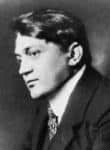Biography

Ady was born in Érmindszent, Szilágy County (part of Austria-Hungary at the time; now a village in Satu Mare County, Romania, called Adyfalva in Hungarian and Ady Endre in Romanian). He belonged to an impoverished Calvinist noble family. Endre was the second of three children, although the eldest of the three, a girl named Ilona had died at an early age.
Between 1892-1896, he attended the Calvinist College in Zal?u. Since 1957, in the front of the school, there is a statue of Ady Endre, built by Balaskó Nándor. In the newspaper "Szilágy" from Zal?u, Ady Endre published his first poem on March 22, 1896.
Afterwards, he studied Law at the Reformed College in Debrecen. After finishing his studies, he became a journalist, and published his first poems in a volume called Versek (Poems) in 1899. He soon became tired of Debrecen (the town later became the symbol of backwardness in his poetry) and moved to Nagyvárad (today Oradea, Romania), a city with rich cultural life. In the articles written in 1902 for Nagyváradi Napló Ady paid a close attention to the social features of his time. "Wesselényi and a poor peasant! Perhaps unwittingly, master Fadrusz has carved a satire" he wrote referring to the opening of the Wesselényi Monument.
Working as a journalist and spending time with like-minded people broadened his horizons. He published a new collection of poems in 1903, but remained relatively unknown. The turning point came in August 1903 when he met Adél Brüll (Mrs. Diósi), a rich married woman who was living in Paris but visited her home in Nagyvárad. Léda (as he called her in his poems) became his Muse; his love for her and his visit to Paris, where he followed her, helped him to develop his talent. He visited Paris seven times between 1904 and 1911. When he came back after his first visit (which lasted for a year), he began to work for the newspaper Budapesti Napló (Budapest Journal) where he published more than 500 articles and many poems.
Being interested in politics, he became a member of the radical group Huszadik Század (Twentieth Century). In 1906 he published his third book of poetry, Új versek (New Poems) – which is a landmark in literature, marking the birth of modern Hungarian poetry –, but it was his fourth collection, Vér és arany (Blood and Gold) which brought him real success and critical acclaim.
In 1906 Ady decided to leave the country. He went to Paris again. In 1907, he had to leave his job at the Budapesti Napló.
In 1908, the first issue of a new periodical called Nyugat (The West) published a poem and an essay by Ady. He worked for this periodical for the rest of his life; from 1912 he was one of the editors. Also in 1908 in Nagyvárad he was one of the founders of a literary circle called A Holnap (The Tomorrow). The circle published an anthology of some poems of Ady and others including Mihály Babits, Gyula Juhász and Béla Balázs. The poems of this anthology met disapproval and lack of comprehension. Many people attacked the anthology for containing erotic poems, also, Ady was criticized for his unpatriotic feelings in his poem, in which he emphasized the contrast between the rich cultural life he longs for and the realities of the cruel Hungarian peasant world.
Ady disliked that his name was mentioned together with other poets, about whom he thought that they were jumping on his bandwagon. He wrote a short story (The duk-duk affair) in which he mocked those who are following the trend set by him.
The Nyugat is undoubtedly the most important periodical in the history of Hungarian literature. Ady was not only an editor of the paper, but also its symbol. Since the Nyugat did not deal with politics, it was not enough for Ady who was interested in politics, so he wrote for other newspapers too. He criticized heavily the political situation of the time. He did not like the nationalism of the leading parties, but also criticized the antinationalism of social democrats; knew how much Hungary was behind the more developed countries but clearly saw the faults of Western countries too.
In the beginning of the 20th century Hungarian poets were claiming to follow in the footsteps of Sándor Pet?fi writing in an imitated folksy style yet lacking Pet?fi's vision (and, mostly, talent) which was not able to renew itself. Ady was the first to break with the traditions and promote the new, modern style. Although he liked to see himself as a lonely, misunderstood revolutionary, in truth most of the poets of his generation took sides with him (and many of them imitated his style).
His first two books of poetry did not show anything new; he was still under the influence of 19th century poets such as Pet?fi or János Vajda. The first elements of his own style appeared not in his poems but in his essays and other writings.
Ady was undoubtedly influenced by the works of Baudelaire and Verlaine. He often uses Symbolism, his recurring themes are God, Hungary, and fight for survival. Other themes are present only in certain periods of his life (money, God, life and death, Léda).
Versek ("Poems", 1899)
Még egyszer ("Once Again", 1903)
Új versek ("New Poems", 1906)
Vér és arany ("Blood and Gold", 1907)
Illés szekerén ("On Elijah's Chariot", 1909)
Szeretném, ha szeretnének ("I'd Love to Be Loved" 1910)
A Minden-Titkok versei ("The Poems of All Secrets", 1911)
A menekülő Élet ("The Fleeing Life", 1912)
Margita élni akar ("Margita Wants to Live", 1912)
A magunk szerelme ("Our Own Love", 1913)
Ki látott engem? ("Who Have Seen Me?", 1914)
A halottak élén ("Leading the Dead", 1918)
Az utolsó hajók ("The Last Ships", 1923)
Last updated February 07, 2012



